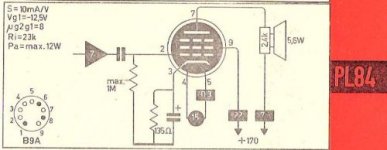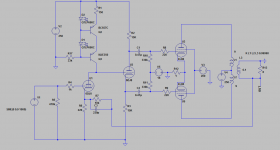PL84 is an EL86 with a different heater. I've never understood why that is so.
Well, let's try to explain:
In 1953, when the EL84/6BQ5 was developed, not all households in Europe had AC mains power - there still were many DC systems around. So there was some need for AC/DC radios, and thus for a parallel type to the EL84, suitable for lower plate voltages. This type has been called UL84. About 1956 Philips had the idea to bring radios with OTL power stages. Power tubes for AC/DC radios seemed to be suitable for this purpose. But unfortunately the use of the UL84 required a separate 45 V heater winding on the mains transformer. To avoid this, the EL86 has been derived from the UL84 by replacing the heater, as has also been the PL84 for television services in 1955.
Best regards!
Which begs the question : why did Philips violate its own naming conventions for the UL84? The same is true of the E182CC : I once had the financially punishing experience of inserting one of these into a socket wired for an ECC82 and suffering the loss of a fair amount of money! Season's greetings.Well, let's try to explain:
In 1953, when the EL84/6BQ5 was developed, not all households in Europe had AC mains power - there still were many DC systems around. So there was some need for AC/DC radios, and thus for a parallel type to the EL84, suitable for lower plate voltages. This type has been called UL84. About 1956 Philips had the idea to bring radios with OTL power stages. Power tubes for AC/DC radios seemed to be suitable for this purpose. But unfortunately the use of the UL84 required a separate 45 V heater winding on the mains transformer. To avoid this, the EL86 has been derived from the UL84 by replacing the heater, as has also been the PL84 for television services in 1955.
Best regards!
I have been experimenting with some UL84/45B5 tubes. They are series heater versions of the EL86/6CW5 type and do work well with 2.5 to 3K ohm OPT's in SE and 2.7 to 3.3K OPT's in P-P amps. Yes 25 watts is easy in P-P.
Which begs the question : why did Philips violate its own naming conventions for the UL84?
From the beginning, i.e. from pre WWII times on, it has been quite usual to name AC/DC power output valves for series heater chains similarly to their parallel heated, but rather different companions. See CL4 vs. AL4, UL12 vs. EL12, UL41 vs. EL41 etc. All of them, besides their maximum plate dissipation, totally different valves, not only regarding their heaters!
I have been experimenting with some UL84/45B5 tubes. They are series heater versions of the EL86/6CW5 type and do work well with 2.5 to 3K ohm OPT's in SE and 2.7 to 3.3K OPT's in P-P amps. Yes 25 watts is easy in P-P.
Quite right! See this 6CW5 datasheet, page 2!
Best regards!
It did not. There never was any guarantee that xLnn and yLnn are the same valve with different heaters. However, it often was so some people assume it has to be. Another counter-example is PCL83 and ECL83: same pentode, different triode.barretter said:why did Philips violate its own naming conventions for the UL84?
There is absolutely nothing in the Philips naming convention which should lead you to believe that an E182CC is in any sense comparable with an ECC82. You can deduce that both are dual triodes on B9A base with 6.3V heater, and E182CC is a special quality valve which came out later (3-digit number), but that is all.The same is true of the E182CC : I once had the financially punishing experience of inserting one of these into a socket wired for an ECC82 and suffering the loss of a fair amount of money!
Maybe I should have accused Philips of inconsistency. As you say, some do, some don't. When I bought the E182CC, I was new to the game and just assumed that it was a special quality version of the ECC82, like the E188CC is of the ECC88and would fit in the same socket. Valve data on the more esoteric valves wasn't very available than.
If you read the prefaces to Mullard manuals which describe the code you definitely get the impression that the P and U versions of E valves only differ in their heater specifications, and somebody who's into hi-fi is not going to investigate the differences in the triodes of PCL83s and ECL83s.
If you read the prefaces to Mullard manuals which describe the code you definitely get the impression that the P and U versions of E valves only differ in their heater specifications, and somebody who's into hi-fi is not going to investigate the differences in the triodes of PCL83s and ECL83s.
The USA also had instances of inconsistencies. The 50L6 is NOT a 6L6 with a 50 volt heater. But the 50L6 is the same as a 6W6 except the heater. I don;t know if a central industry group issued the tube numbers or how it was to work so all say 12AX7s would have the same specs...
It did not. There never was any guarantee that xLnn and yLnn are the same valve with different heaters. However, it often was so some people assume it has to be. Another counter-example is PCL83 and ECL83: same pentode, different triode.
There is absolutely nothing in the Philips naming convention which should lead you to believe that an E182CC is in any sense comparable with an ECC82. You can deduce that both are dual triodes on B9A base with 6.3V heater, and E182CC is a special quality valve which came out later (3-digit number), but that is all.
Absolutely right! If you'd have a look at the talk to Wikipedia's article on Mullard-Philips tube designation, you'd see that the topic has yet been discussed there. I did my own statement on 30 July this year (I'm MenrathU there...)
Best regards!
- Status
- Not open for further replies.
- Home
- Amplifiers
- Tubes / Valves
- PL84 schematic question.

